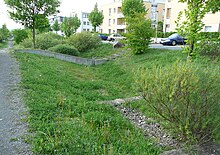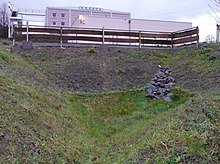Rainwater infiltration
In water technology, infiltration refers to the introduction of rainwater ( rain , hail , snow ) into the subsoil via technical infiltration systems. The seepage water can also be contaminated here.
The introduction of polluted rainwater can also be referred to as trickling . Contaminated water to be treated (mostly pre-treated wastewater ) seeps into the subsoil after appropriate cleaning in a trickle path (seepage path).
The natural seepage of rainwater is called infiltration . When river water seeps away particularly quickly , this is also known as sinking .
description
Infiltration is used in particular to divert surface water from settlement areas and traffic areas if there are no suitable sewer systems or receiving waters . This process is also used in disposal technology to counteract a reduction in the formation of new groundwater through surface sealing and to come close to the natural water cycle.
Even before the precipitation hits the roof / earth surface, it is enriched with substances through fine particles and aerosols from the atmosphere. Precipitation can also carry pollutants from contaminated surfaces (such as wheel abrasion, brake dust and leakage on roads and ions from metal roofs). Before it can seep away, the water must therefore be pre-cleaned, if necessary, or the seepage must be channeled through a layer of humus rich in bacteria (living soil zone under a sward). There must be no contaminated sites in the ground . The requirements are described in leaflet DWA-M 153 (recommendations for handling rainwater). A distinction is made between filter systems, sedimentation systems, soil passage and chemical-physical processes. In principle, smaller and smaller decentralized infiltration systems with upper soil passage are preferable to all others.
Infiltration systems
In Germany, the requirements for infiltration systems (for rainwater) are set out in DWA-Arbeitsblatt-A 138 Planning, construction and operation of systems for infiltration of rainwater of the German Association for Water Management, Wastewater and Waste e. V. (DWA). ( ISBN 3-937758-66-6 as of April 2005).
Worksheet A 138 makes a distinction
- Area infiltration
- Hollow infiltration
- Hollow-trench infiltration
- Infiltration infiltration
- Trough-trench system (trough with emergency overflow into the trench)
- Pipe infiltration infiltration
- Shaft infiltration (e.g. by septic tank )
- Basin seepage
Furthermore, the bank area of a pond system can be used for infiltration. When designing the systems, it should be noted that the accumulation of rainwater is discontinuous and therefore storage facilities can also be useful in order to manage with small infiltration areas. Depending on the permeability of the soil, a space requirement of 8 to 20% for the hollow in relation to the connected area must be expected. The maximum water level in a non-fenced hollow should not exceed 30 cm.
Infiltration can also be used for the artificial enrichment of the groundwater for the production of useful and drinking water.
In North Rhine-Westphalia and some, especially rural areas, it is a legal requirement to allow rainwater to seep away on one's own property. On the one hand, this is intended to preserve the groundwater balance and to relieve the sewage system in the event of rain. Furthermore, there are fewer overflows and backflows in heavy rain .
The Austrian building regulations also largely provide for rainwater to seep away from one's own property in order not to unnecessarily burden the wastewater treatment plants.
Establishment
Before building an infiltration system, the soil in question should be examined for its infiltration capacity (k f - or permeability coefficient ). Sand and gravel are very permeable to water, silt and clay accumulate or seal. Before building an infiltration system, the height of the groundwater must also be known, since an infiltration distance of at least 1 m to the highest groundwater level must be guaranteed.
In most cases, infiltration systems such as Mulde and Mulde infiltration systems on private residential properties do not require a permit. In some federal states there is no permit if the water volume does not exceed 8 m³ per day and the infiltration takes place via the active soil zone (sward and topsoil of at least 10 cm). For infiltration systems on commercially used properties and in public spaces , a water law permit from the Lower Water Authority is required.
See also
Web links
- Infiltration manual (web archive) (PDF, 544 kB)
- Information from the Emschergenossenschaft on handling rainwater
- Construction of a rainwater infiltration system
- Benefits of infiltration
Individual evidence
- ↑ Information brochure for the Coesfeld sewage works ( memento of the original dated November 6, 2015 in the Internet Archive ) Info: The archive link was inserted automatically and has not yet been checked. Please check the original and archive link according to the instructions and then remove this notice. , Page 4

